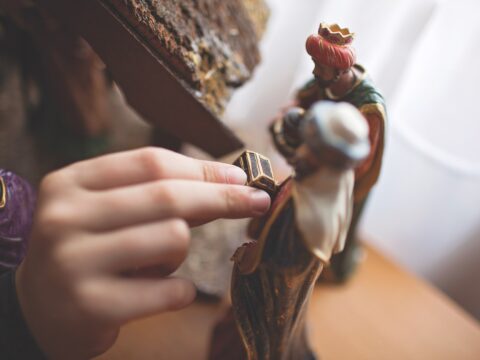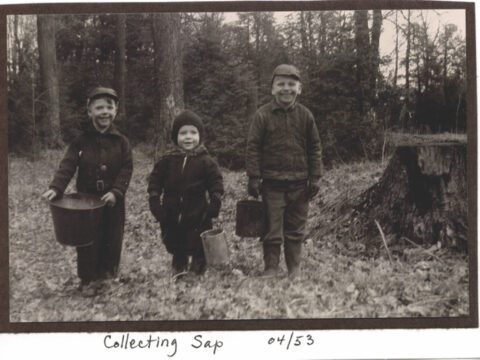Betrayal, torture and execution are not usual children’s fare. While most parents shield their young from the more gruesome shades of life, the Easter story hinges on the execution of an innocent man. Amy Crawford, The United Church of Canada’s program minister for children and youth, says that we shouldn’t shelter children from the Easter story.
“If our faith is always ‘God loves us and everyone is joyful all the time,’ then how do we hang on to God in the midst of grief and death? We need to find ways to tell the whole story of our faith,” she says.
So how can parents broach one of the Bible’s most sensitive stories with young Christians? Here are some suggestions.
DON’T SANITIZE THE MESSAGE
Young children shouldn’t be plunked in front of Mel Gibson’s The Passion of the Christ, but that doesn’t mean they can’t handle some of the Bible’s more challenging themes.
“Children can identify with what it means to be betrayed and to feel sad,” says Rev. Erin Sterling, minister at Pilgrim United in Victoria. “I agree that we need to consider age appropriateness, but I think we shy away from the story far too often. Betrayal, bad choices, suffering, pain, death: these are human issues that children often have far more extensive knowledge of than we give them credit for.”
Rev. Betty Lynn Schwab, General Council’s recently retired coordinator for worship, music and spirituality, agrees. “Children know about death, bullying and violence. Sometimes I’ve used their knowledge and experience of those facts of life as an entry portal to what happened to Jesus. I’ll ask, ‘Some people bullied Jesus until he died. Why do you think anyone would do that?’”
Schwab isn’t overly concerned about traumatizing children. “They will take in what they can. If we don’t talk to kids about the uncensored story of faith, we buy into the cultural values that deny death and fail to equip people for the key realities of living.”
Children should know what happened to Jesus, she says. “I wouldn’t dwell on the torture in the story, but then I wouldn’t dwell on it with adults, either.”
Instead of focusing too intently on how Jesus died, parents might consider spending the bulk of conversations discussing the motivations that led to his death, how Jesus’ friends betrayed him, how Pilate gave in to peer pressure, or how we sometimes make sacrifices for our faith.
“Our sacrifices won’t be as dramatic or drastic. But through Jesus’ life and death, he shows us that sometimes we need to do hard things because of what we believe,” says Crawford.
DISCOVER CHILD-FRIENDLY LANGUAGE
Rev. Melody Duncanson-Hales, Manitou Conference’s mission and stewardship animator, remembers the first time her three-year-old daughter, Sophie, saw a large crucifix in a Roman Catholic Church. “Oh no! God is dead!” the toddler exclaimed. Duncanson-Hales’s older son Padriag replied in a whisper, “It’s okay, Sophie. He comes back.”
“He comes back” is resurrection language in kid-speak. For help finding age-appropriate words to explain the Easter story to little ones, parents and teachers can take their lead from a good children’s Bible or Sunday school curriculum. They might also consider gathering with other parents to compare notes.
Andrew Hyde, Norval (Ont.) United’s youth and young families minister, started a parents’ group at church where people can talk about their ministry as parents and share ideas.
“We just started a book club, too, kind of like Scholastic book orders from school. We recommend books and cover part of the cost just to get good books into families’ hands at bedtime,” he says.
What Easter book made Norval’s cut this year? Light of the World: The Life of Jesus for Children, which places Jesus’ crucifixion and resurrection in the context of his life story.
Parents can also turn to familiar stories in popular culture to help explain Christian concepts.
“Talk with your children about the Harry Potter story and see if they can relate it to the Easter one. . . . You can find another example of sacrificial love in The Lion King. See what Mufasa does for his son Simba,” writes Rev. Derek Macleod, a Presbyterian minister in Beaconsfield, Que., in an open letter on the Presbyterian church’s website called “Explaining Easter to Children: A Note to Parents and Grandparents.”
In his letter, Macleod suggests ways to answer tough questions like these: “Why did Jesus have to die? Why do we call it Good Friday? Why do we call it Easter? What’s with the eggs and Easter bunnies?”
CELEBRATE HOLY WEEK
Palm Sunday and Easter are celebrated on Sunday mornings when children are often there. But when children aren’t encouraged to observe Holy Week services, they miss the deeper meanings of the Easter story.
“Skipping from Palm Sunday to Easter doesn’t make any sense,” says Schwab. “Over my 26-and-a-half years in congregational ministry, I became more and more convinced that kids need to learn the full story.”
Schwab suggests that congregations and parents make a point of inviting children to help in Ash Wednesday, Maundy Thursday and Good Friday services. But worship doesn’t stop when people leave the church building. “Reading Lenten devotionals or a Bible verse and reflection is a way parents can help their children realize the meaning of Lent at home,” she says, adding that United Church Resource Distribution and Creative Communications for the Parish offer numerous resources for children during Lent.
OFFER HANDS-ON LESSONS
Advent wreaths, calendars, candles and nativity scenes are visible reminders that something meaningful is happening at Christmas. Easter bunnies don’t make the same spiritual leap, but there are lots of creative ways for parents to bring the Easter message home.
Dye Easter eggs together and chat about how the egg is a symbol of life. Fold origami butterflies and discuss how a caterpillar forms a cocoon and becomes a butterfly, just as Jesus was human, died and lived on through those who followed him.
Take the lead from church rituals and make a purple (the symbolic colour of Lent) table runner, which can be removed on Good Friday and replaced with a white one on Easter Sunday. Hide plastic “resurrection eggs,” which contain an item that symbolizes Jesus’ journey to Easter, and invite children to hunt for an egg each night during Holy Week.
Hot cross buns are an edible Easter idea. A children’s resource on The United Church of Canada’s website explains the symbolism of each element: “The bread reminds us of Jesus’ last meal with his disciples. The raisins are a reminder of the cup of wine Jesus and his disciples shared. The cross on top is a reminder of Jesus’ death on a cross and a symbol of God’s love for and desire for justice among all people.
“The spices used in the dough remind us of the spices the women brought to the tomb with which they planned to anoint Jesus’ body. The buns are round and remind us of the stone that was rolled away from the tomb.”
These kinds of object lessons often provoke good questions. Easter is a season of deep mystery. When parents are confronted by questions they don’t know how to answer, an honest response is, “You know, I wonder about that too. Let’s talk about it more.”
***
This story first appeared in The United Church Observer’s April 2012 issue with the title “A child’s view of Easter.”















